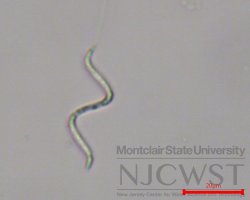Taxonomy
- Order
- Nostocales
- Family
- Aphanizomenonaceae
- Genus
- Raphidiopsis
Examples of Raphidiopsis
Unification of Raphidiopsis and Cylindrospermopsis
The description given on this page reflects the relatively recent unification of Raphidiopsis and Cylindrospermopsis into a single genus; in accordance with the nomenclatural principle of priority, this genus is called Raphidiopsis (Aguilera et al. 2018).
Cylindrospermopsis and Raphidiopsis were previously treated as separate genera, distinguished by the former’s ability to develop heterocytes, and the complete lack of heterocytes in the latter; the validity of Raphidiopsis was questioned, however, as it was unclear whether the genus represented populations of Cylindrospermopsis which, in certain environmental conditions or stages of development, lacked heterocytes (Komárek 2013). Analyses of genetic sequences (16S rRNA, 16S-23S ITS, cpcBA-IGS), published in 2018 by Aguilera et al., strongly supported the unification of these genera into a single genus. Regarding the presence or absence of heterocytes in certain strains, Aguilera et al. (2018) concluded that stable natural populations of trichomes without the ability to form heterocytes do occur, and the authors propose that this may be the result of multiple independent evolutionary events. Raphidiopsis is therefore described here as capable of producing heterocytes; because this taxonomic change is a fairly recent one, the reader may find that this description is in contradiction with other sources, and so this change is discussed in order to help the reader avoid confusion.
Morphology
Solitary, free-floating trichomes; uniseriate; straight, curved, or coiled; without sheaths; constricted or unconstricted at crosswalls; typically narrowed towards the ends; apical cells conical, pointed, or bluntly pointed. Trichomes are isopolar, but may appear heteropolar in certain stages (heterocytes developing at different times at either end; trichome disintegration yields a trichome with one rounded end and one pointed, narrowed end). Vegetative cells cylindrical to barrel-shaped; typically longer than wide; facultatively with aerotopes; pale blue-green, olive-green, or yellowish.
Some populations with heterocytes, which are always terminal; ovoid, conical, sometimes slightly curved (teardrop-shaped); present at one or both ends of the trichome. Akinetes ellipsoidal or cylindrical, typically slightly curved if trichome is coiled; solitary or in pairs; intercalary and typically not in a central position in the trichome; if heterocytes are present, then usually distant from heterocytes, or rarely adjacent.
Ecology
Planktic in freshwater; capable of forming blooms.
References
- Aguilera, A., Berrendero Gómez, E., Kaštovský, J., Echenique, R.O., & Salerno, G.L. (2018). The polyphasic analysis of two native Raphidiopsis isolates supports the unification of the genera Raphidiopsis and Cylindrospermopsis (Nostocales, Cyanobacteria). Phycologia, 57(2): 130-146.
- Johansen, J. R., & Komárek, J. (2015). Filamentous Cyanobacteria. In J. D. Wehr, R. G. Sheath, & J. P. Kociolek (Eds.), Freshwater Algae of North America: Ecology and Classification (2nd ed., pp. 183-216). Waltham, MA: Elsevier.
- Komárek, J. (2013). Cyanoprokaryota-3. Teil/Part 3: Heterocytous Genera (J. R. Johansen, Ed.). In B. Büdel, G. Gärtner, L. Krienitz, & M. Schagerl (Eds.), Süßwasserflora von Mitteleuropa (Vol. 19/3, pp. 655-678). Heidelberg, Germany: Springer Spektrum.

